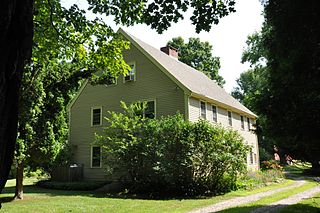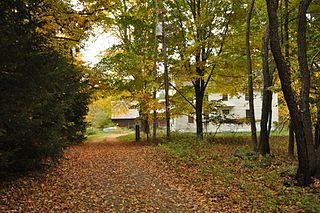
Connecticut Hall is a Georgian building on the Old Campus of Yale University. Completed in 1752, it was originally a student dormitory, a function it retained for 200 years. Part of the first floor became home to the Yale College Dean's Office after 1905, and the full building was converted to departmental offices in the mid-twentieth century. It is currently used by the Department of Philosophy, and its third story contains a room for meetings of the Yale Faculty of Arts & Sciences, the academic faculty of Yale College and the Graduate School.

The González–Álvarez House, also known as The Oldest House, is a historic house museum at 14 St. Francis Street in St. Augustine, Florida. With a construction history dating to about 1723, it is believed to be the oldest surviving house in St. Augustine. It is also an important example of St. Augustine's Spanish colonial architectural style, with later modifications by English owners. It was designated a U.S. National Historic Landmark in 1970. The house is now owned by the St. Augustine Historical Society and is open for public tours as part of the Oldest House Museum Complex. Evidence can be seen of the Spanish, British, and American occupations of St. Augustine.

The Dyckman House, now the Dyckman Farmhouse Museum, is the oldest remaining farmhouse on Manhattan island, a vestige of New York City's rural past. The Dutch Colonial-style farmhouse was built by William Dyckman, c.1785, and was originally part of over 250 acres (100 ha) of farmland owned by the family. It is now located in a small park at the corner of Broadway and 204th Street in Inwood, Manhattan.

Fort Halifax is a former British colonial outpost on the banks of the Sebasticook River, just above its mouth at the Kennebec River, in Winslow, Maine. Originally built as a wooden palisaded fort in 1754, during the French and Indian War, only a single blockhouse survives. The oldest blockhouse in the United States, it is preserved as Fort Halifax State Historic Site, and is open to the public in the warmer months. The fort guarded Wabanaki canoe routes that reached to the St. Lawrence and Penobscot Valleys via the Chaudière-Kennebec and Sebasticook-Souadabscook rivers. The blockhouse was declared a National Historic Landmark and added to the National Register of Historic Places in 1968.

The Church of the Holy Family is a Roman Catholic church located at 116 Church Street in the St. Clair County, Illinois city of Cahokia Heights. Built beginning in 1786, it is a remarkably unaltered example of the French colonial construction style known as "poteaux-sur-solle" (post-on-sill), and one of the few such buildings surviving in North America. It was declared a National Historic Landmark and added to the National Register of Historic Places in 1970. The occupying congregation is the oldest continuously active Catholic Parish in the United States, having been founded in 1699 by Canadian missionaries, and the oldest church west of the Allegheny Mountains. At the invitation of Bishop Edward Braxton, the Institute of Christ the King Sovereign Priest continues to offer Mass in this historic church according to the Missal of 1962. Visitors are also welcome for guided tours in the summer. In celebration of the 2018 Illinois Bicentennial, Holy Family Church was selected as one of the Illinois 200 Great Places by the American Institute of Architects Illinois component.

The Wentworth-Gardner House is a historic mid-Georgian house built in 1760 and located at 50 Mechanic Street in Portsmouth, New Hampshire, United States. The house is operated as a museum by the Wentworth-Gardner Historic House Association. It is one of the finest extant examples of high-style Georgian architecture in New England, and played a role in the architectural preservation movement of the early 20th century. It was declared a National Historic Landmark in 1968.

Middleburg Plantation is a historic colonial-era plantation on the Cooper River near Huger, South Carolina. The plantation house, built in 1697 by the French Huguenot Benjamin Simons, is probably the oldest standing wood-frame building in South Carolina, and is consequently an architecturally important example of period construction. It was declared a National Historic Landmark in 1970.

The Old York Gaol is a former colonial prison at Lindsay Road and Main Street in York, Maine. Its oldest portion dating to about 1720, it is one of the oldest prison buildings in the United States, and one of the oldest public buildings in the state of Maine. It was designated a National Historic Landmark in 1968. It is owned by the Museums of Old York and is open for tours between May and October.

The Harpswell Meetinghouse is a historic colonial meeting house on Maine State Route 123 in Harpswell, Maine. Built in 1757-59 to provide space for both religious services and town meetings, it is a little-altered and well-preserved example of a once-common form, and is the oldest such surviving building in the state of Maine. It was designated a National Historic Landmark in 1968.

The John Ward House is a National Historic Landmark at 9 Brown Street in Salem, Massachusetts, United States. With an early construction history between 1684 and 1723, it is an excellent example of First Period architecture, and as the subject of an early 20th-century restoration by antiquarian George Francis Dow, it is an important example of the restoration techniques. Now owned by the Peabody Essex Museum, it is also one of the first colonial-era houses in the United States to be opened as a museum. It was designated a National Historic Landmark in 1968.

The Samuel Bancroft House is a historic house in Reading, Massachusetts. With an estimated construction date of 1748, it is one of the town's older surviving houses, and one of a small number from the late colonial period. It was listed on the National Register of Historic Places in 1984.

The Gilman Garrison House is a historic house museum at 12 Water Street in Exeter, New Hampshire. Built in 1709, it is a rare surviving example of a garrison house or fortified structure. It is owned by Historic New England, which operates the home as a house museum, and was listed on the National Register of Historic Places in 1976.

The Bray House is a historic house at 100 Pepperell Road in Kittery Point, Maine, United States. It is one of the oldest surviving buildings in the state. Long thought to be a 17th-century structure, the architectural evidence indicates the home was probably not built before 1720. It was added to the National Register of Historic Places in 1979.

The Alna School is located on Alna Road in the town of Alna, Maine. Built in 1795, it is one of the oldest surviving school buildings in the state. It has also housed Alna's town offices. It was added to the National Register of Historic Places on April 28, 1975.

The Russian Bishop's House, once the Russian Mission Orphanage, is a historic house museum and National Historic Landmark at Lincoln and Monastery Streets in Sitka, Alaska. Built in 1841–43, this log structure is one of the oldest surviving buildings of Russian America, and was one of the centerpieces of the Russian Orthodox church's efforts to spread its influence among the natives of Alaska. It was the home and administrative center of Ivan Veniaminov, the first Bishop of Alaska, later canonized as Innocent of Alaska. The house is now a unit of Sitka National Historical Park, and is administered by the National Park Service.

The Dennett Garrison is a historic First Period house at 100 Dennett Road in Kittery, Maine. With an estimated construction date of 1710, it is one of the oldest surviving buildings in the state of Maine. When listed on the National Register of Historic Places in 1978, it was still owned by descendants of its builder, John Dennett.

The Frost Garrison and House are a cluster of colonial-era buildings on Garrison Drive in Eliot, Maine. Sited on Frost's Hill, the complex includes a c. 1778 house, and two structures, the oldest dating to 1735, constructed as strongholds against Native American attacks. The older one is the only known surviviving garrison built for the defense of a single family. The house is also the ancestral home of poet Robert Frost, who is known to have visited the area. The complex was listed on the National Register of Historic Places in 1971. His niece, Mara Frost Marshall, was also born there.

Wallingford Hall is a historic house at 21 York Street in Kennebunk, Maine. Built in 1805–06, it is an unusually grand expression of Federal architecture in the town, built by the regionally architect and builder Thomas Eaton, and one of the oldest surviving examples in the state of a connected farmstead. In the late 19th and early 20th century it was also home to William Barry, an architectural historian who wrote extensively on the architecture of southern Maine, and was an early promoter of the Colonial Revival in the area. The house was listed on the National Register of Historic Places in 2004.

The Deacon Andrew Dunning House is a historic house on Mountain Road in North Harpswell, Maine. Built about 1757 by one of Harpswell's early settlers, it is one of the town's oldest buildings. It was also the subject of a well-meaning but ill-informed Colonial Revival "restoration" in the 1940s, illustrating some of the issues with those types of actions. The property, which includes the Dunning family cemetery, was listed on the National Register of Historic Places in 1999.
The Dixmont Town House is a historic civic and community building at 702 Western Avenue in Dixmont, Maine. Built in 1836, it is one of a few well-preserved early town halls in Maine that served a strictly civic purpose. It was used by the town for its town meetings until 1952, and has been restored to an early 20th-century appearance. It was listed on the National Register of Historic Places in 2014.





















